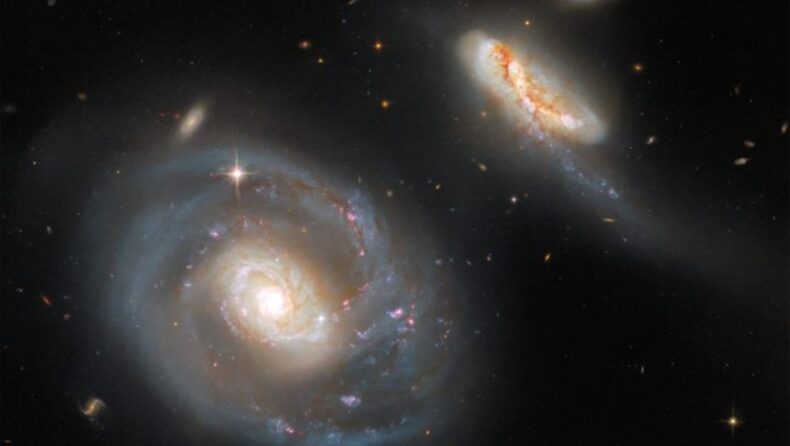The Hubble Space Telescope captures a photo of Arp 298, a stunning pair of interacting galaxies.
Using the NASA/ESA Hubble Space Telescope, astronomers have captured a striking new photo of Arp 298. Apr 298 is a pair of interacting galaxies in the Pegasus constellation.
Arp 298 comprises two galaxies
Arp 298 comprises two galaxies:
- the barred spiral galaxy NGC 7469 and
- its smaller spiral companion, IC 5283.
This striking image lies in Pegasus’s constellation, roughly 200 million light-years from Earth. The larger of the two galaxies is termed the barred spiral galaxy NGC 7469, and the second galaxy IC 5283 is its diminutive companion. NGC 7469 hosts a supermassive, active black hole and a shiny ring of star clusters.
What does the name “Arp” signify?
“The “Arp” in this galaxy pair’s name signifies that they are listed in the Atlas of Peculiar Galaxies.” This state was compiled by the astronomer Halton Arp. Hubble astronomers said,
“His atlas is a gallery of weird and wonderful galaxies containing peculiar structures, featuring galaxies exhibiting everything from segmented spiral arms to concentric rings.” The Atlas of Peculiar Galaxies is a gallery of beautiful galaxies containing peculiar structures, featuring galaxies exhibiting everything from segmented spiral arms to concentric rings. This interacting galaxy pair is a familiar sight for Hubble — a portrait of the merging galaxies in Arp 298 was published in 2008.
Image of Arp 298 captured in seven different filters
This image of Arp 298 contains data from three separate Hubble proposals. Arp 298 is captured in glorious detail by combining observations from three suggestions in seven different filters from two of Hubble’s instruments — the Wide Field Camera 3 and the Advanced Camera for Surveys.
Process of planning Hubble observations
The process of planning Hubble observations starts with a proposal. A proposal is a detailed plan of what an astronomer intends to observe and their scientific motivation. Once a year, these proposals are gathered and judged in a grueling review process to assess their scientific merit and feasibility. Fewer than 20% of the proposed observations in any given year will make it through this process and be approved, which makes observing time with Hubble highly prized indeed.
This system will be one of the first galaxies observed with the NASA/ESA/CSA James Webb Space Telescope as part of the Director’s Discretionary Early Release Science Programs in Summer 2022.
This Hubble image shows the Arp 298 galaxy pair. The color image includes ultraviolet, optical, and infrared observations from Hubble’s WFC3 and ACS instruments. It is based on data obtained through seven filters—the color results from assigning different hues to each monochromatic image associated with an individual filter.
Let’s look into its discovery
- The English astronomer John Herschel discovered it on November 12, 1784. NGC 7469 is also classified as the Seyfert galaxy.
- It hosts an active supermassive black hole and a bright ring of star clusters.
- IC 5283 was discovered by the French astronomer Guillaume Bigourdan on September 4, 1891.
- “The new image of Arp 298 contains data from three separate Hubble proposals,” the researchers said.
- “By combining observations from three proposals, Arp 298 is captured in glorious detail in seven different filters from Hubble’s Wide Field Camera 3 (WFC3) and Advanced Camera for Surveys (ACS).”
- “The process of planning Hubble observations starts with a proposal — a detailed plan of what an astronomer intends to observe and their scientific motivation for doing so,” they added.
- “Once a year, these proposals are gathered and judged in a grueling review process which assesses their scientific merit and feasibility.”
- “Fewer than 20% of the proposed observations in any given year will make it through this process and be approved, which makes observing time with Hubble highly prized indeed.”
Published By: Khushboo Mehta
Edited By: Kritika Kashyap













